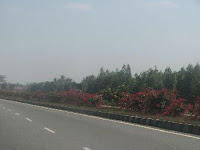About half a decade ago, the road transport sector in India witnessed some pretty dramatic changes. It was marked by the materialization of some of the ambitious road-building projects being undertaken 
Now that substantial chunks of the road-building projects have been completed and are operational (more than 95% of Golden Quadrilateral (GQ) is completed - more details regarding the schemes, budgets, completion status and the like can be found at the National Highways Authority of India (NHAI) website and the Ministry of Road Transport and Highways (MORTH) website), its time to analyze if, and to what extent, these have helped the economy.
Fuel Savings
A majority of the newly constructed 4/6 laned roads are tolled. While the toll amount is not uniform across the country (the Ahmedabad-Vadodara expressway levies Rs.63/- for about 85 kms; whereas Tumkur-Nelmangla stretch of NH4 costs Rs. 21 for 35-km stretch), it would be safe to assume an approximate of close to Re.1/- per km, as the average for a car. I have heard many people complain that this is too steep, saying there is no way one can save enough fuel to compensate for the toll. Some even argue that since cars usually drive at high speeds (often 100+ kph) on the 4/6 lane stretches, it might actually result in more fuel consumption. True. So where’s the "fuel savings"?
The real fuel savings for the country lie in the transportation sector. Enter - the ubiquitous Indian lorry. Prior to the advent of divided highways, there used to be lot of fuel wastage because of slow-moving heavy vehicles, for example, in the event of one fully loaded truck overtaking another (not to mention it was a painfully slow event).
Especially on the gradients.We have all witnessed quite often, the scene of one mammoth lorry trailing another in low gear; both vehicles groaning under the strain and spewing out tonnes of exhaust. Now, with the widening of roads and construction of dividers, lorries consume considerably less fuel per consignment run. Some websites like this one and this one point out the enormous fuel savings that the NHDP projects are expected to bring about.
Time Savings
This is quite evident. Almost anyone who has travelled on these highways during the pre- and post- NHDP era will vouch for the stupendous time gain factor of these highways. Again, this applies not only to cars and passenger transport, but to goods too. Trucks which used to cover only about 300 kms per day now do close to 500 kms!
Safety
That the newly constructed highways offer greater safety has been debated. The argument aga
However, the additional safety that the newly constructed highways cannot be undermined. Most head-on highway accidents are related to overtaking. With divided highways, such accidents are minimized. Moreover, the NHDP highways are being built to certain standards, like better road geometry etc. These factors definitely make road travel safer than ever before.
Cash Flow and Economy
These various factors contribute a long way in boosting the economy, especially in the countryside. In addition to the financial savings resulting from less fuel consumption, there are numerous other aspects of economic growth attributable to the roads improvement projects, few of which are listed below.
- Goods are transported quicker than before.
- "Wastage" of goods is minimized (especially food products and milk products).
- Wayside businesses along the highways - This is interesting because it is opposite to the conventional economical model for roads. Conventionally, roads were aligned to pass through towns for the purpose of enhancing business. But, the NHDP envisages smooth, uninterrupted flow of traffic. Hence, most of the towns are bye-passed. However, highwayside businesses (like restaurants, lodges, fuel stations, garages) flourish in the new model. (CNN IBN recently aired this feature on the flourishing business along the Golden Quadrilateral)
- Massive employment during the construction phase.
- The increase in travel comfort has been a boon to the tourism industry.
How much is too much?
Since the Highway projects have been such a huge success, it is very easy to get carried away. There are 2 highways between Mumbai and Pune - the traditional NH4 and the Mumbai-Pune expressway. In Karnataka, the Bangalore-Mysore state highway was recently 4-laned, and work has begun on Bangalore-Mysore Infrastructure Corridor (BMIC). Delhi-Chandigarh and Bangalore-Chennai expressways are also on the cards.
The authorities got to be careful here. There's no point in having 2 separate highways between two cities. After all, the interests of farmers have to be protected too. Where will all the land come from? What about the environmental implications? If the traffic in these corridors is so high, then why were these stretches not built at 6/8 lanes in the first place? The GQ has not yet been completed, and there's already talk of widening it to 6/8 lanes by 2012. So will the public have to re-live the misery that it went through during the initial construction?
Only if the answers to above question are satisfactory, should the respective Governments go ahead with the proposed implementations. Its great news that we as a nation have finally woken up to the advantages of a sound infrastructure backbone. Now it is our duty to ensure that rural economy is not adversely affected by this; and it is definitely our responsibility to see to it that this road-building spree does not eat up our farmlands and our forests.
Looking forward to an economically booming India. JAI BHARATH.

No comments:
Post a Comment